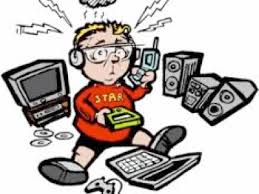26 of the 48 state Medicaid agencies studied could not report the number of “critical incidents” — such as abuse, neglect or exploitation.
You are here
Five Tech and Aging Blog Posts You May Have Missed - July 2017
 It’s summer – and the reading is easy. But there are many opportunities to fall out of touch with what’s happening in the world of tech and aging – for example, in the market innovation category, most recently there have been announcements about robot offerings for seniors, and some new capabilities for sharing photo content that can help record moments of our family lives that may soon be lost. In the spirit of sharing, hoping that those who can are going to attend the Silicon Valley Boomer Venture Summit next week, July 20, in Berkeley – if so, will see you there! Meanwhile, here are five other blog posts from the past month that you may have missed:
It’s summer – and the reading is easy. But there are many opportunities to fall out of touch with what’s happening in the world of tech and aging – for example, in the market innovation category, most recently there have been announcements about robot offerings for seniors, and some new capabilities for sharing photo content that can help record moments of our family lives that may soon be lost. In the spirit of sharing, hoping that those who can are going to attend the Silicon Valley Boomer Venture Summit next week, July 20, in Berkeley – if so, will see you there! Meanwhile, here are five other blog posts from the past month that you may have missed:
 Movin' up – so goes the definition of old age. Maybe this confirms what you have already observed, and the Society of Actuaries (which also uses Social Security Life Tables) has also calculated. According to Stanford economist John Shoven, the definition of "old" is rising, ridiculously compared to the 1920s, but very interesting, nonetheless. Says Shoven: For women, "old" is approximately age 73, with women transitioning out of middle age at 65. For men, he asserts that "old" is around age 70, with transitioning out of middle age at age 60. The assumption underlying this are based on "risk of dying" within 1, 2 or 4 years. If it is 1% or less, a person is is middle-aged. Good graphic, and no surprise, it's another document in the litany of advice for deferring Social Security payments until late, late, late, despite the actual behavior in which 42% of men and 48% of women are claiming it at age 62.
Movin' up – so goes the definition of old age. Maybe this confirms what you have already observed, and the Society of Actuaries (which also uses Social Security Life Tables) has also calculated. According to Stanford economist John Shoven, the definition of "old" is rising, ridiculously compared to the 1920s, but very interesting, nonetheless. Says Shoven: For women, "old" is approximately age 73, with women transitioning out of middle age at 65. For men, he asserts that "old" is around age 70, with transitioning out of middle age at age 60. The assumption underlying this are based on "risk of dying" within 1, 2 or 4 years. If it is 1% or less, a person is is middle-aged. Good graphic, and no surprise, it's another document in the litany of advice for deferring Social Security payments until late, late, late, despite the actual behavior in which 42% of men and 48% of women are claiming it at age 62.
 New York: Largest city in the US shows a path for an aging society. New York has long been a host and leader in supporting older adults, from being a WHO Age Friendly City, to acknowledging the presence of Naturally Occurring Retirement Communities (NORCs) starting in 1994, to being the home of the first Virtual Senior Center (VSC). In addition, technology leadership initiatives have been offered via SelfHelp in Queens, and Senior Planet, a technology exploration center that offers tech training for adults 60+. So many people aging, many needing the skills to find and keep jobs. So they utilize services like OATS and Senior Planet, or senior centers, training in libraries, carrier stores and online sites like AARP TeK Academy.
New York: Largest city in the US shows a path for an aging society. New York has long been a host and leader in supporting older adults, from being a WHO Age Friendly City, to acknowledging the presence of Naturally Occurring Retirement Communities (NORCs) starting in 1994, to being the home of the first Virtual Senior Center (VSC). In addition, technology leadership initiatives have been offered via SelfHelp in Queens, and Senior Planet, a technology exploration center that offers tech training for adults 60+. So many people aging, many needing the skills to find and keep jobs. So they utilize services like OATS and Senior Planet, or senior centers, training in libraries, carrier stores and online sites like AARP TeK Academy.
 Boomers and technology – it’s a given. Yesterday yet another baby boomer reporter asserted what is believed by many to be the obvious. Baby boomers will not be tech-phobic (presumably like their parents) – but will be willing and able to use the newest technology in their later years. What’s the proof? They use it now – for example, 83% are using the Internet, look at Facebook pages for health information, form social connections, research online, etc. And baby boomers, many of whom are now ‘seniors’, expect technology to help them remain independent as they age. This is such a significant possibility that tech designers are actually encouraged to consider them when designing a new product.
Boomers and technology – it’s a given. Yesterday yet another baby boomer reporter asserted what is believed by many to be the obvious. Baby boomers will not be tech-phobic (presumably like their parents) – but will be willing and able to use the newest technology in their later years. What’s the proof? They use it now – for example, 83% are using the Internet, look at Facebook pages for health information, form social connections, research online, etc. And baby boomers, many of whom are now ‘seniors’, expect technology to help them remain independent as they age. This is such a significant possibility that tech designers are actually encouraged to consider them when designing a new product.
 Dial-up lives on -- and not necessarily out of preference. You may have read this last week: Rural America is stranded in the dial-up age. That was disturbing on multiple levels, starting with the obvious. Even people who could afford better access can’t get it – they drive to a gas station parking lot to obtain Internet speeds fast enough to do online business. Study the map in the article and ponder the status of elderly who live in these low-bandwidth locations. The article notes 23 million people (39% living in rural areas) who lack access to any type of broadband. Older adults make up a larger percentage of rural Americans, 16% than in the US as a whole and “people aged 75+ are more likely to have chronic diseases and disabilities."
Dial-up lives on -- and not necessarily out of preference. You may have read this last week: Rural America is stranded in the dial-up age. That was disturbing on multiple levels, starting with the obvious. Even people who could afford better access can’t get it – they drive to a gas station parking lot to obtain Internet speeds fast enough to do online business. Study the map in the article and ponder the status of elderly who live in these low-bandwidth locations. The article notes 23 million people (39% living in rural areas) who lack access to any type of broadband. Older adults make up a larger percentage of rural Americans, 16% than in the US as a whole and “people aged 75+ are more likely to have chronic diseases and disabilities."
 Technology gadgets – ecosystem incompatibility. Look around a very digital home filled with parallel and incompatible ecosystems – and sigh. So many parts, so little integration – it seems vendors compete to death to NOT work together. Consider iMessage – like insider trading, it works well for iPhone execs and phone owners. Consider Bluetooth – it must be turned on so a device can pair with that cool in-room speaker, but turned off to save energy. Really. A smartphone isn't witty enough to know that it is in the room with a Bluetooth-compatible speaker or fitness band and perhaps should be enabled? And not smart enough to turn bluetooth off when the phone departs the room? But the device is now smart enough to suggest a WiFi network to pick -- in fact every time your car passes a location that has WiFi enabled.
Technology gadgets – ecosystem incompatibility. Look around a very digital home filled with parallel and incompatible ecosystems – and sigh. So many parts, so little integration – it seems vendors compete to death to NOT work together. Consider iMessage – like insider trading, it works well for iPhone execs and phone owners. Consider Bluetooth – it must be turned on so a device can pair with that cool in-room speaker, but turned off to save energy. Really. A smartphone isn't witty enough to know that it is in the room with a Bluetooth-compatible speaker or fitness band and perhaps should be enabled? And not smart enough to turn bluetooth off when the phone departs the room? But the device is now smart enough to suggest a WiFi network to pick -- in fact every time your car passes a location that has WiFi enabled.
